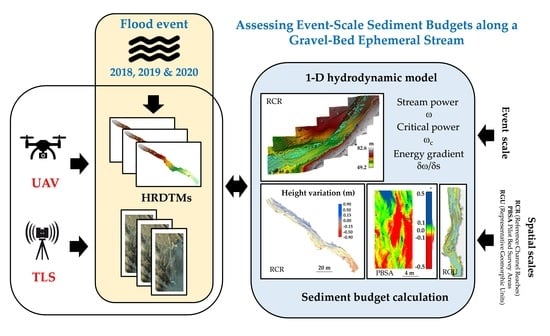Combining SfM Photogrammetry and Terrestrial Laser Scanning to Assess Event-Scale Sediment Budgets along a Gravel-Bed Ephemeral Stream
Abstract
1. Introduction
2. Study Area and Field Surveys
3. Material and Methods
3.1. SfM-MVS Photogrammetry
3.2. Terrestrial Laser Scanning (TLS)
3.3. Criteria for the Selection of Reference Channel Reaches (RCRs), Pilot Bed Survey Areas (PBSAs), and Representative Geomorphic Units (RGUs)
3.4. Hydrometeorological and Hydraulic Data
3.5. Sediment Budget Calculation and Detection of RGU Adjustments
4. Results and Discussion
4.1. Stream Power Maps
4.2. Spatial Sediment Budgets and Morphological Changes Along RCR and PBSA
4.2.1. Sediment Budgets in RCR Determined from SfMData
4.2.2. Sediment Budget and Stream Power in PBSA Estimated from TLS Data
4.2.3. Morphological Bed Adjustments Observed in RCR from TLS Data
4.3. Sediment Budgets for Different RGUs in Relation to Stream Power Data and Field Surveys
5. Conclusions
Author Contributions
Funding
Acknowledgments
Conflicts of Interest
Notation
| D50 | median grain size (m) |
| D84 | particle size corresponding to the 84% of the sample weight (m) |
| ∂ω/∂s | mean stream power gradient [Wm−3] |
| γ | specific weight of water (Nm−3), |
| i | cell at i cross-section |
| Ω | cross-sectional stream power [W m−1] |
| ω | mean stream power [Wm−2] |
| ωc | critical mean stream power [W m−2] |
| qp | peak unit flow (m3 s−1) |
| r2 | determination coefficient |
| Sw | water surface slope [m m−1] |
| tb | base time (h) |
| tb* | base time of the unit hydrograph (h) |
| th | hydrograph duration (h) |
| tp | time of peak (h) |
| tp* | time of peak of the unit hydrograph (h) |
| w | water-surface width (m) |
| ADL | Average depth of lowering |
| ADR | Average depth of raising |
| ANTD | Average net thickness difference (m) for the area of interest |
| ATTD | Average total thickness difference (m) for area of interest |
| 3DPC | 3D point cloud |
| FS | Field survey |
| GCPs | Ground Control Points |
| GNSS | Global Navigation Satellite System |
| HRDTM | High-resolution Digital Terrain Models |
| MDR | Middle reach |
| MVS | Multi-View Stereo |
| OVR | Overall channel reach |
| PBSA | Pilot bed survey area |
| PI | Percent imbalance (departure from equilibrium) |
| RCR | Reference channel reach |
| RGU | Representative geomorphic unit |
| RPAS | Remotely Piloted Air Systems |
| SfM | Structure from Motion |
| TAI | Total area of interest (m2) |
| TASL | Total area of surface lowering (m2) |
| TASR | Total area of surface raising (m2) |
| TLS | Terrestrial Laser Scanner |
| TNVD | Total net volume difference (m3) |
| TVDA | Total volume difference average (m3) |
| UAV | Unmanned aerial vehicles |
| UPR | Upper reach |
| UVSL | Average unit volume of surface lowering (m3 m−2) |
| UVSR | Average unit volume of surface raising (m3 m−2) |
| SD * | Standard deviation of the net thickness differences (m) |
References
- Segura-Beltrán, F.; Sanchis-Ibor, C. Assessment of channel changes in a Mediterranean ephemeral stream since the early twentieth century. The Rambla de Cervera, eastern Spain. Geomorphology 2013, 201, 199–214. [Google Scholar] [CrossRef]
- Conesa-Garcia, C. Torrential flow frequency and morphological adjustments of ephemeral channels in southeast Spain. In River Geomorphology; Hickin, E.J., Ed.; John Wiley & Sons: Chichester, UK, 1995; pp. 169–192. [Google Scholar]
- Sutfin, N.A.; Shaw, J.; Wohl, E.E.; Cooper, D. A geomorphic classification of ephemeral channels in a mountainous, arid region, southwestern Arizona, USA. Geomorphology 2014, 221, 164–175. [Google Scholar] [CrossRef]
- Norman, L.M.; Sankey, J.B.; Dean, D.; Caster, J.; Delong, S.; Delong, W.; Pelletier, J.D. Quantifying geomorphic change at ephemeral stream restoration sites using a coupled-model approach. Geomorphology 2017, 283, 1–16. [Google Scholar] [CrossRef]
- Graf, W.L. Fluvial Processes in Dryland Rivers; Springer: New York, NY, USA, 1988. [Google Scholar]
- Bull, L.J.; Kirkby, M.J. Dryland rivers characteristics and concepts. In Dryland Rivers: Hydrology and Geomorphology of Semi-arid Channels; Bull, L.J., Kirkby, M.J., Eds.; John Wiley & Sons: Chichester, UK, 2002; pp. 3–15. [Google Scholar]
- Török, G.; Baranya, S.; Rüther, N. 3D CFD Modeling of Local Scouring, Bed Armoring and Sediment Deposition. Water 2017, 9, 56. [Google Scholar] [CrossRef]
- Goodrich, D.C.; Lane, L.J.; Shillito, R.M.; Miller, S.N.; Syed, K.H.; Woolhiser, D.A. Linearity of basin response as a function of scale in a semiarid watershed. Water Resour. Res. 1997, 33, 2951–2965. [Google Scholar] [CrossRef]
- Shaw, J.R.; Cooper, D.J. Linkages among watersheds, stream reaches, and riparian vegetation in dryland ephemeral stream networks. J. Hydrol. 2008, 350, 68–82. [Google Scholar] [CrossRef]
- Merritt, D.M.; Wohl, E.E. Downstream hydraulic geometry and channel adjustment during a flood along an ephemeral, arid-region drainage. Geomorphology 2003, 52, 165–180. [Google Scholar] [CrossRef]
- Camporeale, C.; Perona, P.; Ridolfi, L. Hydrological and geomorphological significance of riparian vegetation in drylands. In Dryland Ecohydrology; D’Odorico, P., Porporato, A., Eds.; Springer: Dordrecht, The Netherlands, 2006; pp. 161–179. [Google Scholar]
- Reid, I.; Frostick, L.E. Channel form, flows and sediments of endogenous ephemeral rivers in deserts. In Arid Zone Geomorphology: Process, Form and Change in Drylands; Thomas, D.S.G., Ed.; John Wiley & Sons: Chichester, UK, 2011; pp. 301–332. [Google Scholar]
- Martín-Vide, J.P. Ingeniería Fluvial; UniversitatPolitècnica de Catalunya: Barcelona, Spain, 1997; ISBN 9788498801569. [Google Scholar]
- Chen, S.A.; Michaelides, K.; Grieve, S.W.D.; Singer, M.B. Aridity is expressed in river topography globally. Nature 2019, 573, 573–577. [Google Scholar] [CrossRef]
- Brasington, J.; Vericat, D.; Rychkov, I. Modeling river bed morphology, roughness, and surface sedimentology using high resolution terrestrial laser scanning. Water Resour. Res. 2012, 48. [Google Scholar] [CrossRef]
- Picco, L.; Mao, L.; Cavalli, M.; Buzzi, E.; Rainato, R.; Lenzi, M.A. Evaluating short-term morphological changes in a gravel-bed braided river using terrestrial laser scanner. Geomorphology 2013, 201, 323–334. [Google Scholar] [CrossRef]
- Calle, M.; Alho, P.; Benito, G. Monitoring ephemeral river changes during floods with SfM photogrammetry. J. Iber. Geol. 2018, 44, 355–373. [Google Scholar] [CrossRef]
- Flatley, A.; Rutherfurd, I. Using Structure from Motion (SfM) to capture high resolution geomorphic units within small ephemeral channels. In Proceedings of the 20th EGU General Assembly, Vienna, Austria, 7–12 April 2019. [Google Scholar]
- Galea, A.B.; Sadler, J.P.; Hannah, D.M.; Datry, T.; Dugdale, S.J. Mediterranean intermittent rivers and ephemeral streams: Challenges in monitoring complexity. Ecohydrology 2019, 12, e2149. [Google Scholar]
- Clapuyt, F.; Vanacker, V.; Van Oost, K. Reproducibility of UAV-based earth topography reconstructions based on Structure-from-Motion algorithms. Geomorphol. 2016, 260, 4–15. [Google Scholar] [CrossRef]
- Marteau, B.; Vericat, D.; Gibbins, C.; Batalla, R.J.; Green, D.R. Application of Structure-from-Motion photogrammetry to river restoration. Earth Surf. Process. Landforms 2016, 42, 503–515. [Google Scholar]
- Remondino, F.; Barazzetti, L.; Nex, F.; Scaioni, M.; Sarazzi, D. UAV photogrammetry for mapping and 3d modeling–current status and future perspectives. ISPRS Int. Arch. Photogramm. Remote Sens. Spat. Inf. Sci. 2011, 38, 25–31. [Google Scholar]
- Shintani, C.; Fonstad, M.A. Comparing remote-sensing techniques collecting bathymetric data from a gravel-bed river. Int. J. Remote Sens. 2017, 38, 2883–2902. [Google Scholar] [CrossRef]
- Legleiter, C.J.; Harrison, L.R. Remote Sensing of River Bathymetry: Evaluating a Range of Sensors, Platforms, and Algorithms on the Upper Sacramento River, California, USA. Water Resour. Res. 2019, 55, 2142–2169. [Google Scholar] [CrossRef]
- Tonina, D.; McKean, J.A.; Benjankar, R.M.; Wright, C.W.; Goode, J.R.; Chen, Q.; Reeder, W.J.; Carmichael, R.A.; Edmondson, M.R. Mapping river bathymetries: Evaluating topobathymetric LiDAR survey. Earth Surf. Process. Landf. 2019, 44, 507–520. [Google Scholar]
- Mosbrucker, A.R.; Major, J.J.; Spicer, K.R.; Pitlick, J. Camera system considerations for geomorphic applications of SfM photogrammetry. Earth Surf. Process. Landf. 2017, 42, 969–986. [Google Scholar]
- Salmela, J.; Kasvi, E.; Vaaja, M.T.; Kaartinen, H.; Kukko, A.; Jaakkola, A.; Alho, P. Morphological changes and riffle-pool dynamics related to flow in a meandering river channel based on a 5-year monitoring period using close-range remote sensing. Geomorphology 2020, 352, 106982. [Google Scholar] [CrossRef]
- Rowley, T.; Ursic, M.; Konsoer, K.; Langendon, E.; Mutschler, M.; Sampey, J.; Pocwiardowski, P. Comparison of terrestrial lidar, SfM, and MBES resolution and accuracy for geomorphic analyses in physical systems that experience subaerial and subaqueous conditions. Geomorphology 2020, 355, 107056. [Google Scholar] [CrossRef]
- Cook, K.L. An evaluation of the effectiveness of low-cost UAVs and structure from motion for geomorphic change detection. Geomorphology 2017, 278, 195–208. [Google Scholar] [CrossRef]
- Vázquez-Tarrío, D.; Borgniet, L.; Liébault, F.; Recking, A. Using UAS optical imagery and SfM photogrammetry to characterize the surface grain size of gravel bars in a braided river (Vénéon River, French Alps). Geomorphology 2017, 285, 94–105. [Google Scholar] [CrossRef]
- Conesa-García, C.; Pérez-Cutillas, P.; García-Lorenzo, R.; Gómez-Gutiérrez, Á.; Eekhout, J.; Ibisate, A.; Ollero, A.; Horacio, J. Mapping spatial patterns of dimensionless ratios along an ephemeral channel using SfM photogrammetry. Geophys. Res. Abstr. 2019, 21, EGU2019. Available online: https://meetingorganizer.copernicus.org/EGU2019/EGU2019-7613-1.pdf (accessed on 23 May 2020).
- French, J.R. Airborne LiDAR in support of geomorphological and hydraulic modelling. Earth Surf. Process. Landf. 2003, 28, 321–335. [Google Scholar] [CrossRef]
- Heritage, G.L.; Hetherington, D. Towards a protocol for laser scanning in fluvial geomorphology. Earth Surf. Process. Landf. 2007, 32, 66–74. [Google Scholar] [CrossRef]
- Notebaert, B.; Verstraeten, G.; Govers, G.; Poesen, J. Qualitative and quantitative applications of LiDAR imagery in fluvial geomorphology. Earth Surf. Process. Landf. 2009, 34, 217–231. [Google Scholar] [CrossRef]
- Ortega, J.A.; Razola, L.; Garzón, G. Recent human impacts and change in dynamics and morphology of ephemeral rivers. Nat. Hazards Earth Syst. Sci. 2014, 14, 713–730. [Google Scholar] [CrossRef]
- Eisenbeiss, H.; Sauerbier, M. Investigation of UAV systems and flight modes for photogrammetric applications. Photogramm. Rec. 2011, 26, 400–421. [Google Scholar] [CrossRef]
- Puig-Mengual, C.A.; Martínez-Capel, F.; Woodget, A.S.; Muñoz-Mas, R. DEM generation in a Mediterranean river using Structure From Motion algorithm on HD video recorded from a UAV (Palancia River, Spain). In Proceedings of the HydroSenSoft, International Symposium and Exhibition on Hydro-Environment Sensors and Software, Madrid, Spain, 28 February–3 March 2017. [Google Scholar]
- Woodget, A.S.; Austrums, R. Subaerial Gravel Size Measurement Using Topographic Data Derived from a UAV-SfM Approach. Earth Surf. Process. Landf. 2017, 42, 1434–1443. [Google Scholar] [CrossRef]
- CloudCompare. Available online: http://cloudcompare.org/ (accessed on 25 February 2020).
- Brodu, N.; Lague, D. 3D terrestrial lidar data classification of complex natural scenes using a multi-scale dimensionality criterion: Applications in geomorphology. ISPRS J. Photogramm. Remote Sens. 2012, 68, 121–134. [Google Scholar] [CrossRef]
- Zapico, I.; Laronne, J.B.; Lucía, A.; Martín-Duque, J.F. Morpho-textural implications to bedload flux and texture in the sand-gravel ephemeral Poveda Gully. Geomorphology 2018, 322, 53–65. [Google Scholar] [CrossRef]
- Ali, K.F.; De Boer, D.H. Construction of sediment budgets in large-scale drainage basins: The case of the upper Indus River. In Proceedings of the Erosion Prediction in Ungauged Basins: Integrating Methods and Techniques, Montpellier, France, 8–9 July 2003. [Google Scholar]
- Scharffenberg, W.A.; Fleming, M.J. Hydrologic Modelling System HEC-HMS. User‘s Manual. Version 3.5.; US Army Corps of Engineers: Davis, CA, USA, 2010. [Google Scholar]
- Proyecto NATMUR-08 Catálogo de Geoservicios de Medio Natural, Vuelofotogramétrico Digital y levantamiento LIDAR de la Región de Murcia. Available online: http://www.murcianatural.carm.es/natmur08/ (accessed on 2 September 2018).
- Nanía, L.S. Manual Básico de HEC-HMS 3.0.0 y HEC-GeoHMS 1.1; Granada. 2007. Available online: http://www.ugr.es/~lnania/_private/ManualBasico_HEC-HMS300_HEC-GeoHMS11_Espanol.pdf (accessed on 10 October 2018).
- SCS (Soil Conservation Service). National Engineering Handbook; Section 4.; U.S. Department of Agriculture: Washington, DC, USA, 1972. Available online: https://directives.sc.egov.usda.gov/OpenNonWebContent.aspx?content=18393.wba (accessed on 5 November 2018).
- Nanía, L.S.; Gómez Valentín, M. IngenieríaHidrológica; Grupo Editorial Universitario: Granada, Spain, 2006; ISBN 84-8491-636-7. Available online: https://www.ugr.es/~lnania/ingenieria_hidrologica.htm (accessed on 2 September 2018).
- USACE (US Army Corps of Engineers). HEC-RAS, Rivers Analysis System. Hydraulic Reference Manual, Version 5.0; Hydrologic Engineering Center: Davis, CA, USA, 2016. [Google Scholar]
- Leopold, L.B.; Wolman, M.G.; Miller, J.P. Fluvial Processes in Geomorphology; Dover Publications: New York, NY, USA, 1964. [Google Scholar]
- Lea, D.M.; Legleiter, C.J. Mapping spatial patterns of stream power and channel change along a gravel-bed river in northern Yellowstone. Geomorphology 2016, 252, 66–79. [Google Scholar] [CrossRef]
- Parker, C.; Clifford, N.J.; Thorne, C.R. Understanding the influence of slope on the threshold of coarse grain motion: Revisiting critical stream power. Geomorphology 2011, 126, 51–65. [Google Scholar] [CrossRef]
- Wasson, R.J. Sediment budgets, dynamics, and variability: New approaches and techniques. In Proceedings of the The Structure, Function and Management Implications of Fluvial Sedimentary Systems; IAHS Publication: Alice Springs, Australia, 2002. [Google Scholar]
- Kasprak, A.; Wheaton, J.M.; Ashmore, P.E.; Hensleigh, J.W.; Peirce, S. The relationship between particle travel distance and channel morphology: Results from physical models of braided rivers. J. Geophys. Res. Earth Surf. 2015, 120, 55–74. [Google Scholar] [CrossRef]
- Brasington, J.; Langham, J.; Rumsby, B. Methodological sensitivity of morphometric estimates of coarse fluvial sediment transport. Geomorphology 2003, 53, 299–316. [Google Scholar] [CrossRef]
- Garzón, G.; Alonso, A. Comparison of the flood response of a braided and a meandering river, conditioned by anthropogenic and climatic changes. In Flood and Megaflood Processes and Deposits: Recent and Ancient Examples; Martini, I.P., Baker, V.R., Garzón, G., Eds.; Blackwell Publishing Ltd.: Oxford, UK, 2002; p. 320. [Google Scholar]
- Hooke, J.M. Human impacts on fluvial systems in the Mediterranean region. Geomorphology 2006, 79, 311–335. [Google Scholar] [CrossRef]
- Wohl, E. Mountain Rivers; American Geophysical Union: Washington, DC, USA, 2000. [Google Scholar]
- Singer, M.B.; Michaelides, K. How is topographic simplicity maintained in ephemeral dryland channels? Geology 2014, 42, 1091–1094. [Google Scholar] [CrossRef]
- Conesa-García, C.; Pérez-Cutillas, P.; García-Lorenzo, R.; Eekhout, J.; Gómez-Gutiérrez, Á; Millares-Valenzuela, A.; Martínez-Salvador, A. Dimensionless morphological ratios versus stream power variations at bankfull stage in an ephemeral channel. Geomorphology 2020, 361, 19. [Google Scholar]
- López-Bermúdez, F.; Boix-Fayos, C.; Solé-Benet, A.; Albaladejo, J.; Barberá, G.G.; Del Barrio, G.; Castillo, V.; Garcia, J.; Lázaro, R.; Martínez-Mena, M.D.; et al. Landscapes and desertification in south-east Spain overview and field sites. In Proceedings of the Sixth International Conference on Geomorphology, Zaragoza, Spain, 7–11 September 2005; p. 40. [Google Scholar]
- Harvey, A. Dryland Alluvial Fans. In Arid Zone Geomorphology: Process, Form and change in Drylands; John Wiley & Sons, Ltd.: Chichester, UK, 2011; pp. 333–371. [Google Scholar]
- Aguilar, G.; Cabré, A.; Fredes, V.; Villela, B. Erosion after an extreme storm event in an arid fluvial system of the southern Atacama Desert: An assessment of the magnitude, return time, and conditioning factors of erosion and debris flow generation. Nat. Hazards Earth Syst. Sci. 2020, 20, 1247–1265. [Google Scholar] [CrossRef]
- Lisle, T.E.; Nelson, J.M.; Pitlick, J.; Madej, M.A.; Barkett, B.L. Variability of bed mobility in natural, gravel-bed channels and adjustments to sediment load at local and reach scales. Water Resour. Res. 2000, 36, 3743–3755. [Google Scholar] [CrossRef]
- Yuill, B.; Nichols, M.; Yager, E. Coarse bed material patch evolution in low-order, ephemeral channels. Catena 2010, 81, 126–136. [Google Scholar] [CrossRef]
- Thompson, D.M.; Wohl, E.E.; Jarrett, R.D. A revised velocity-reversal and sediment-sorting model for a high-gradient, pool-riffle stream. Phys. Geogr. 1996, 17, 142–156. [Google Scholar] [CrossRef]
- Lisle, T.E.; Hilton, S. Fine bed material in pools of natural gravel bed channels. Water Resour. Res. 1999, 35, 1291–1304. [Google Scholar] [CrossRef]
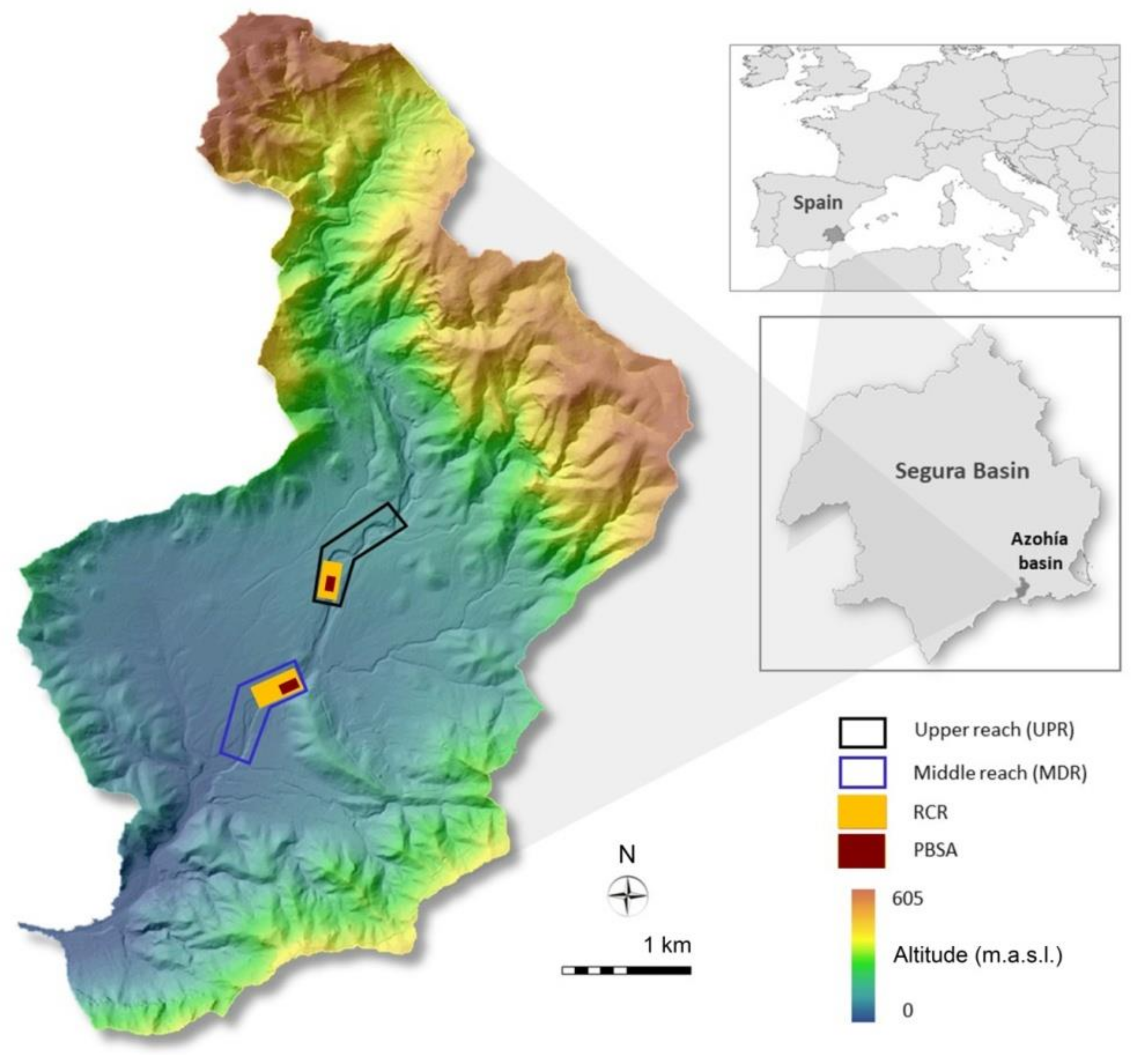
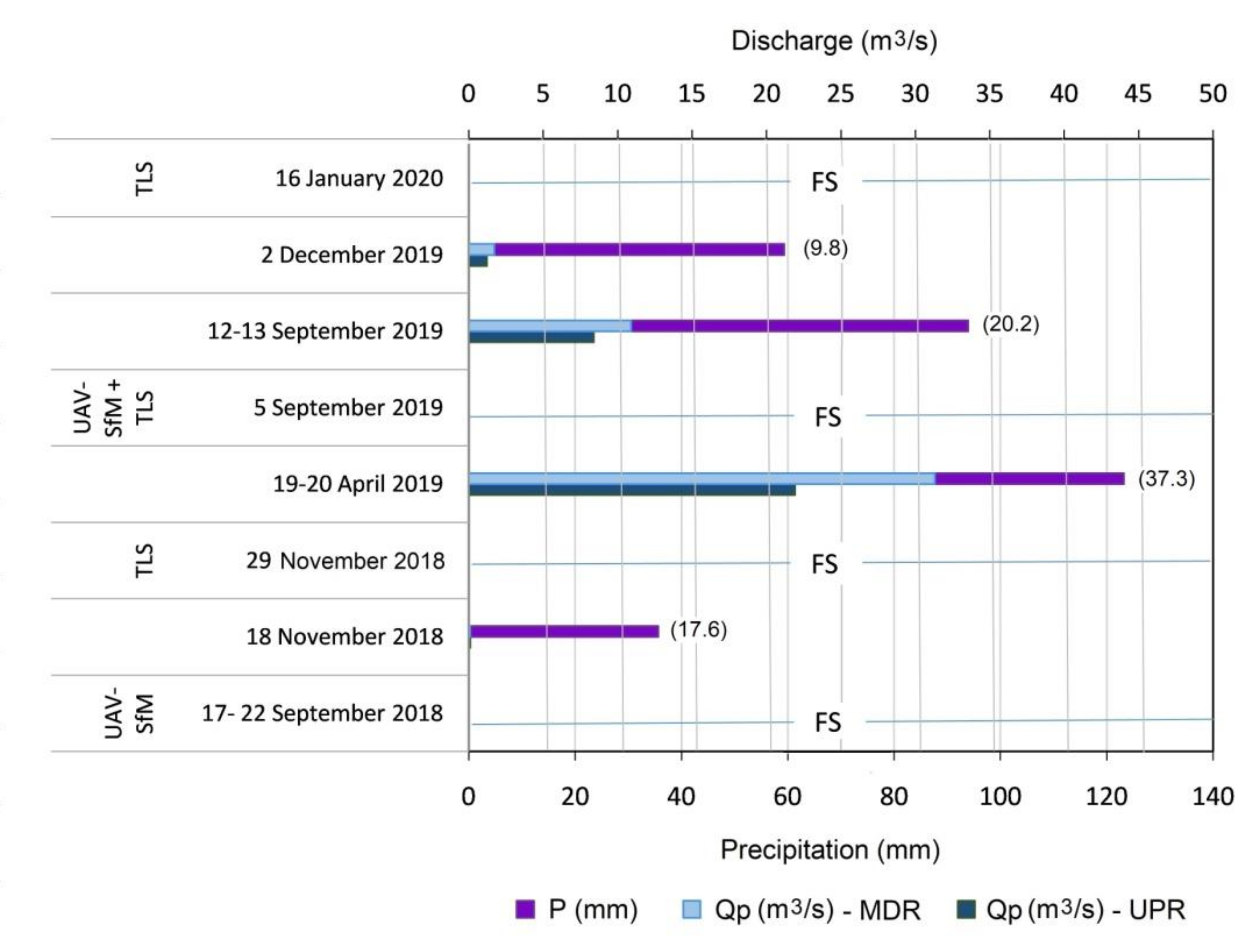
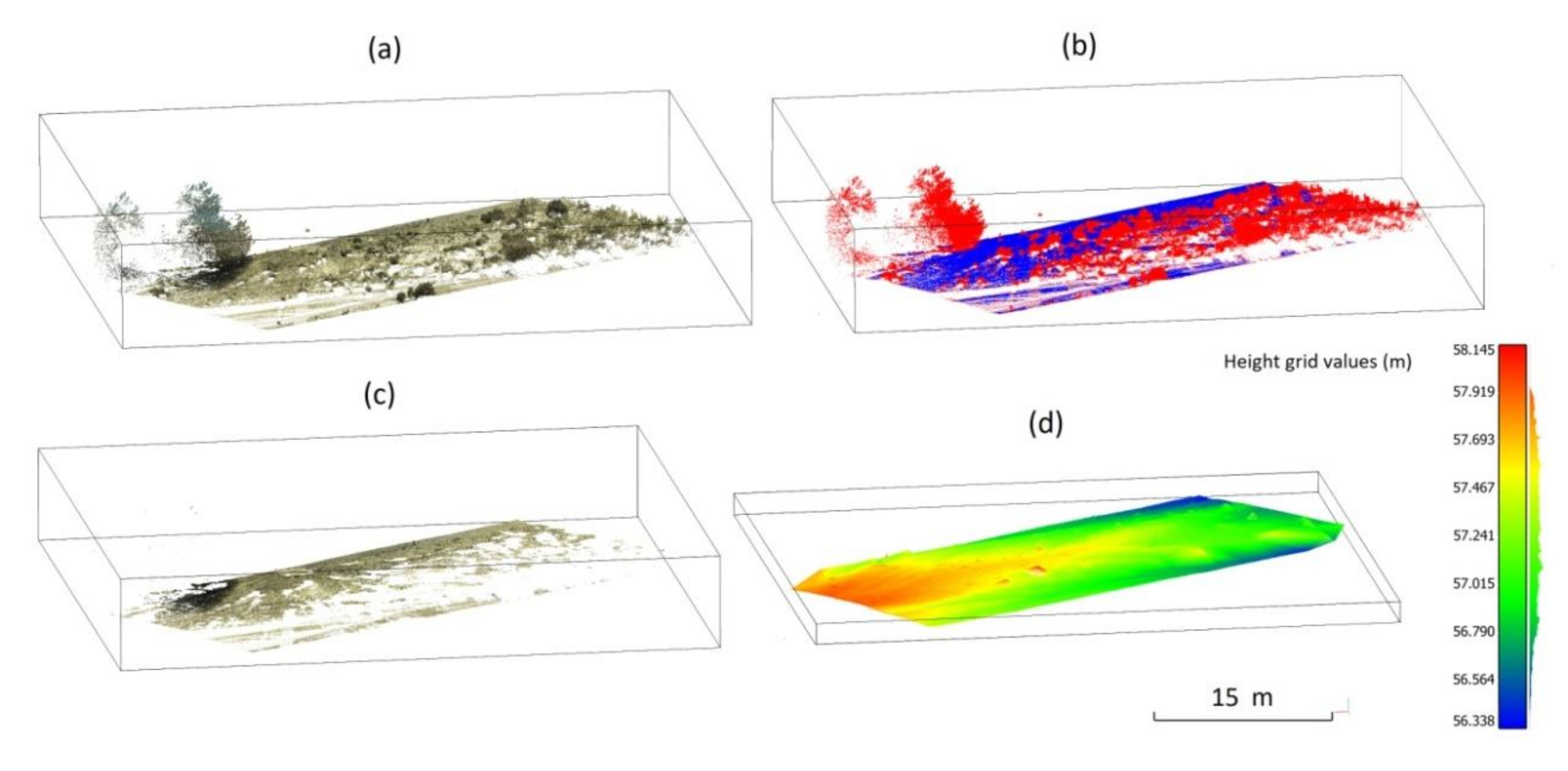
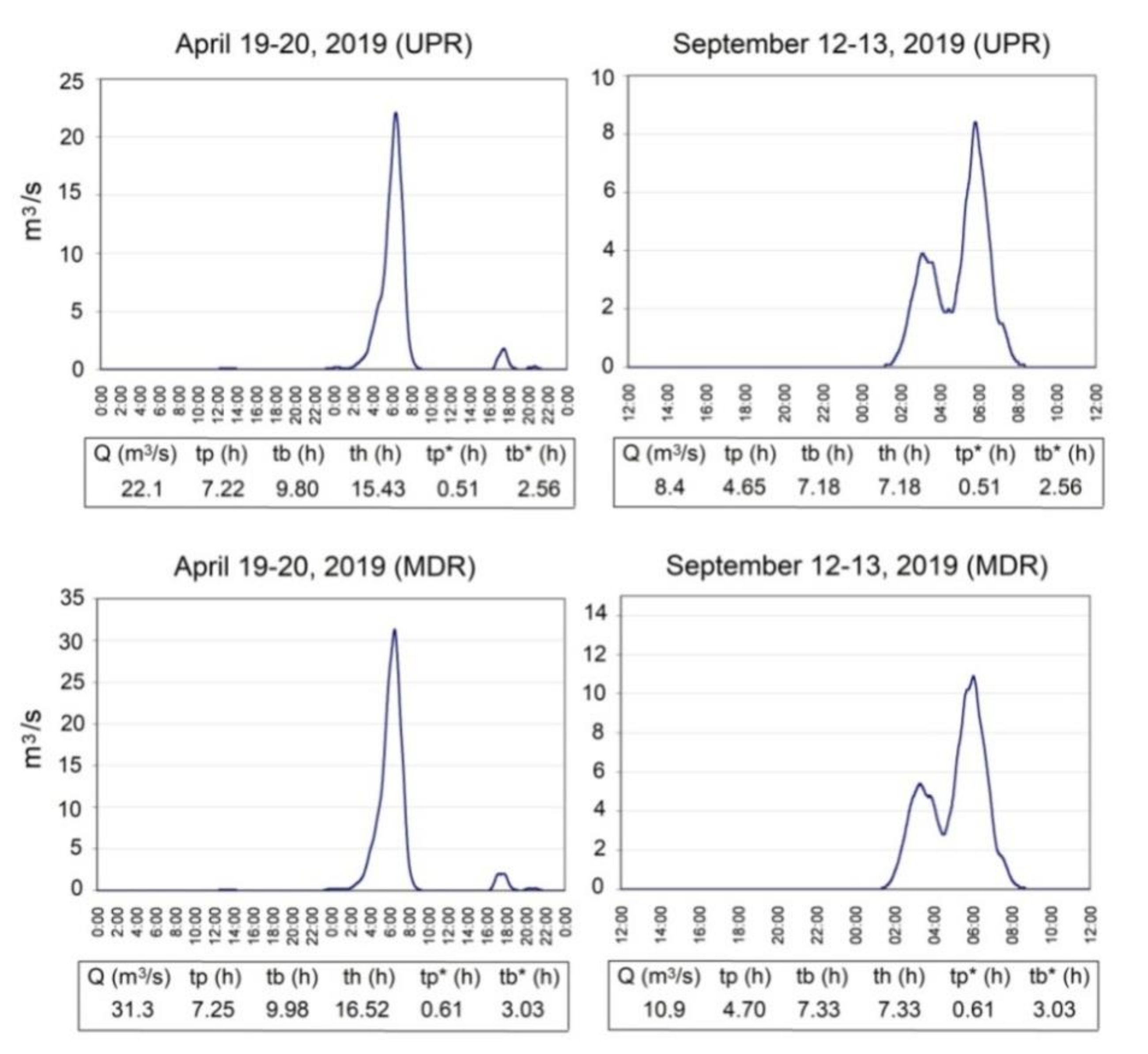
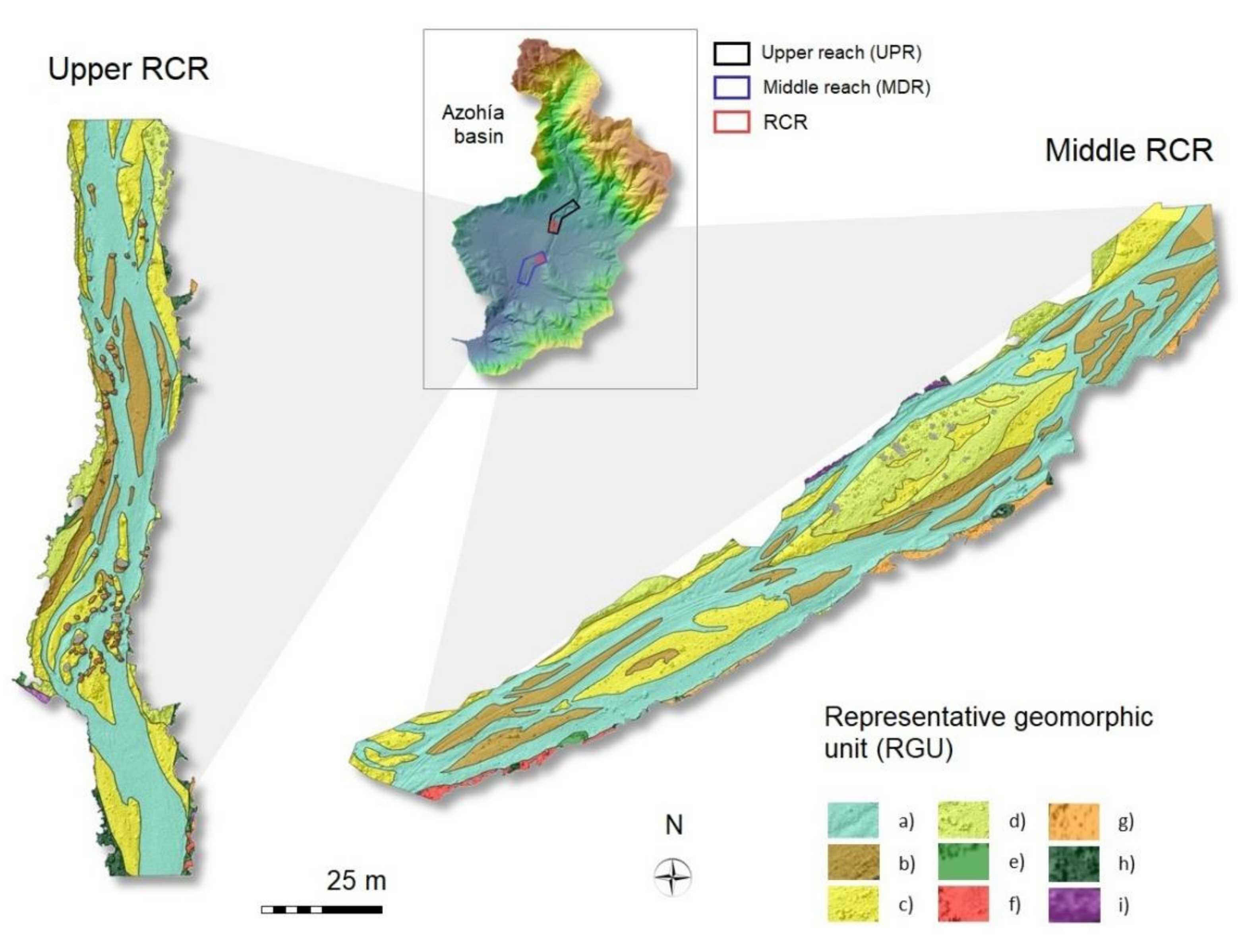
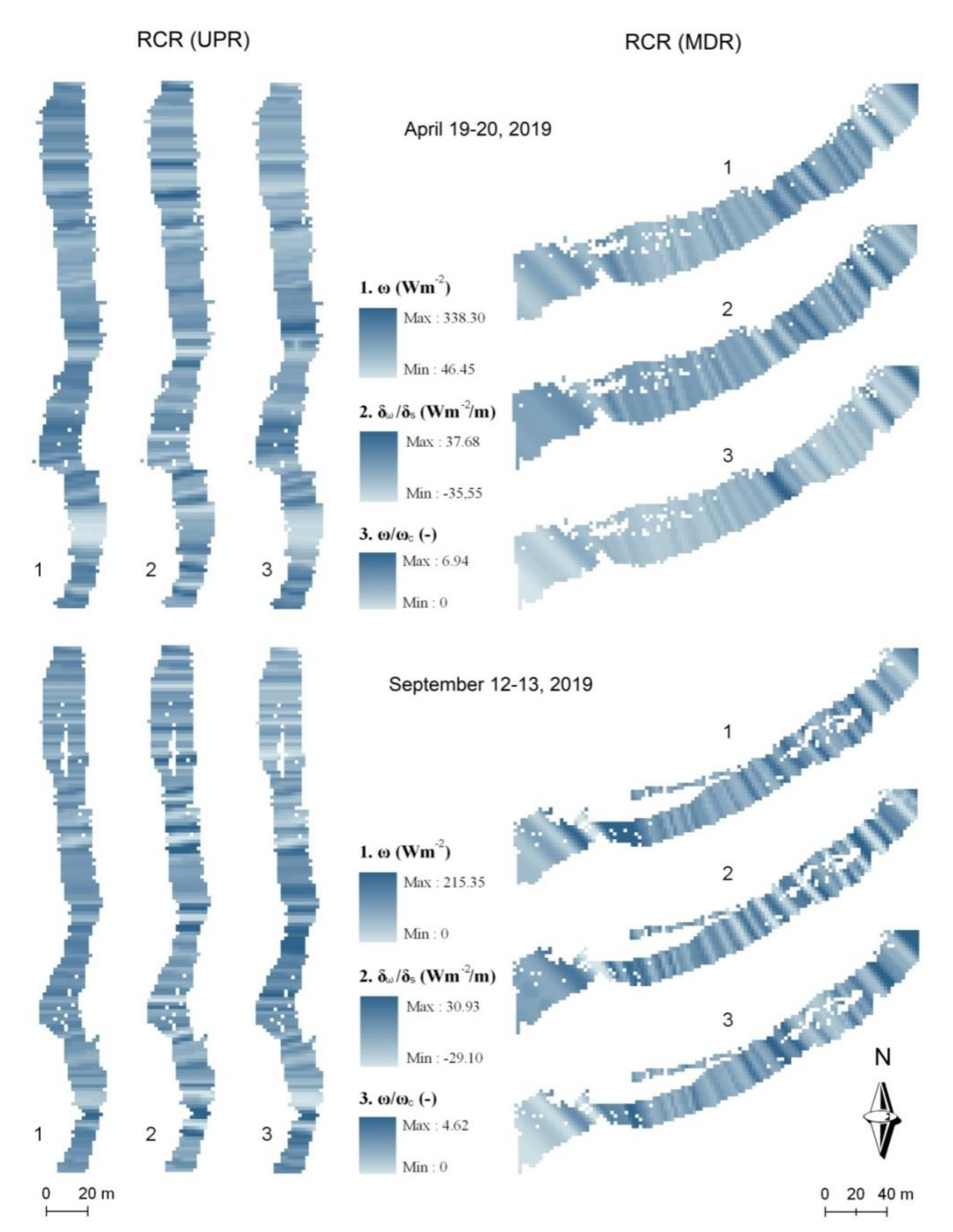
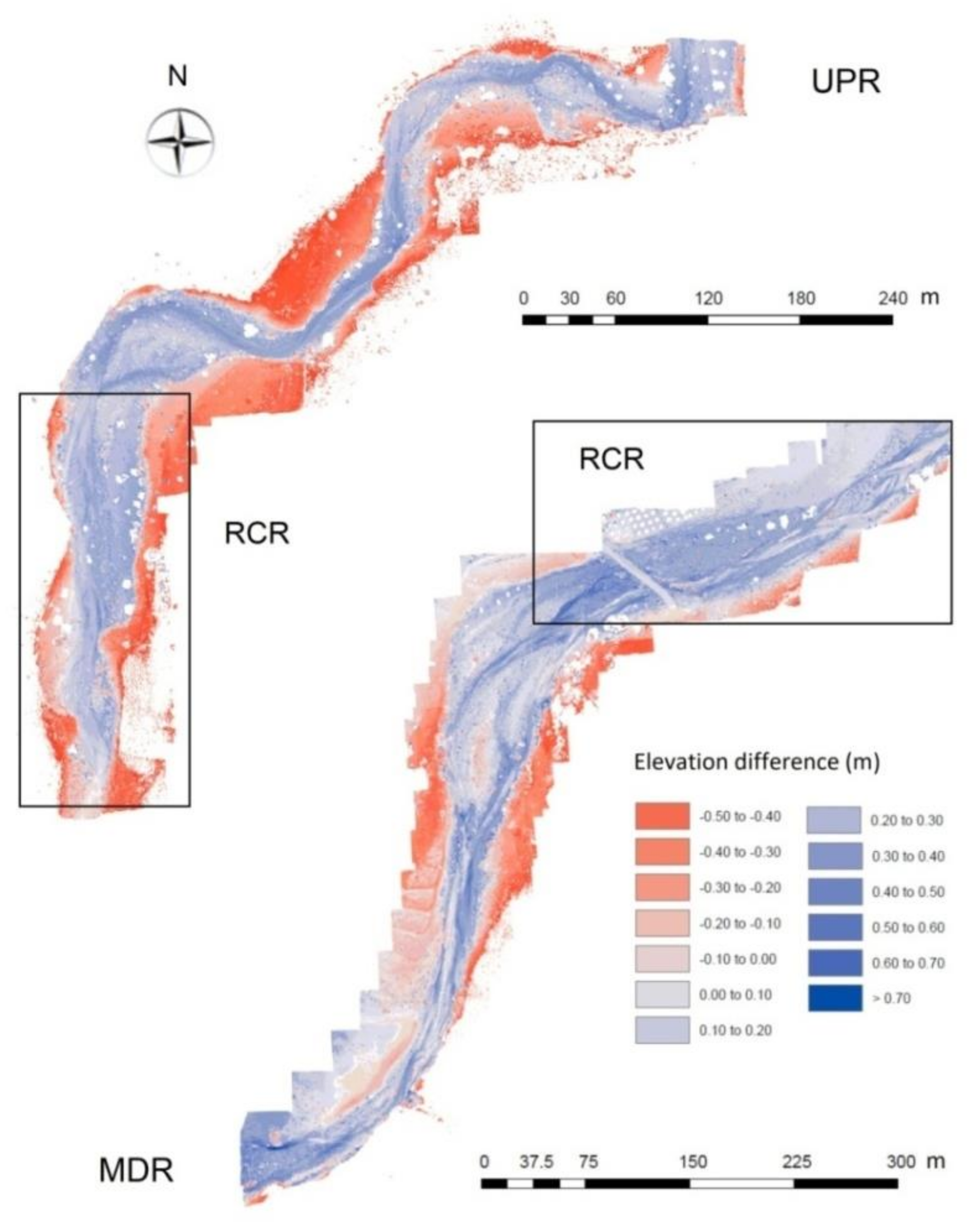
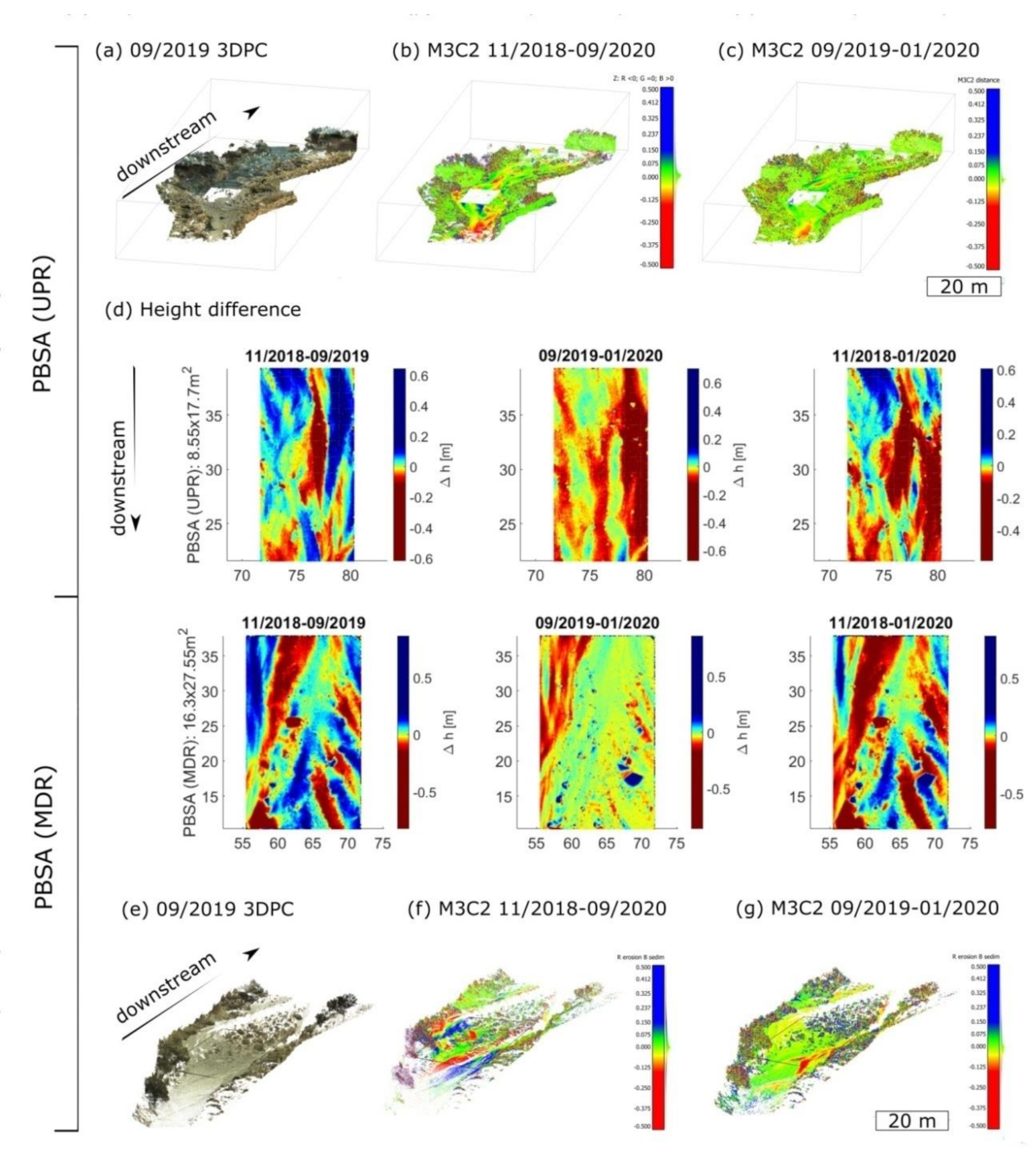
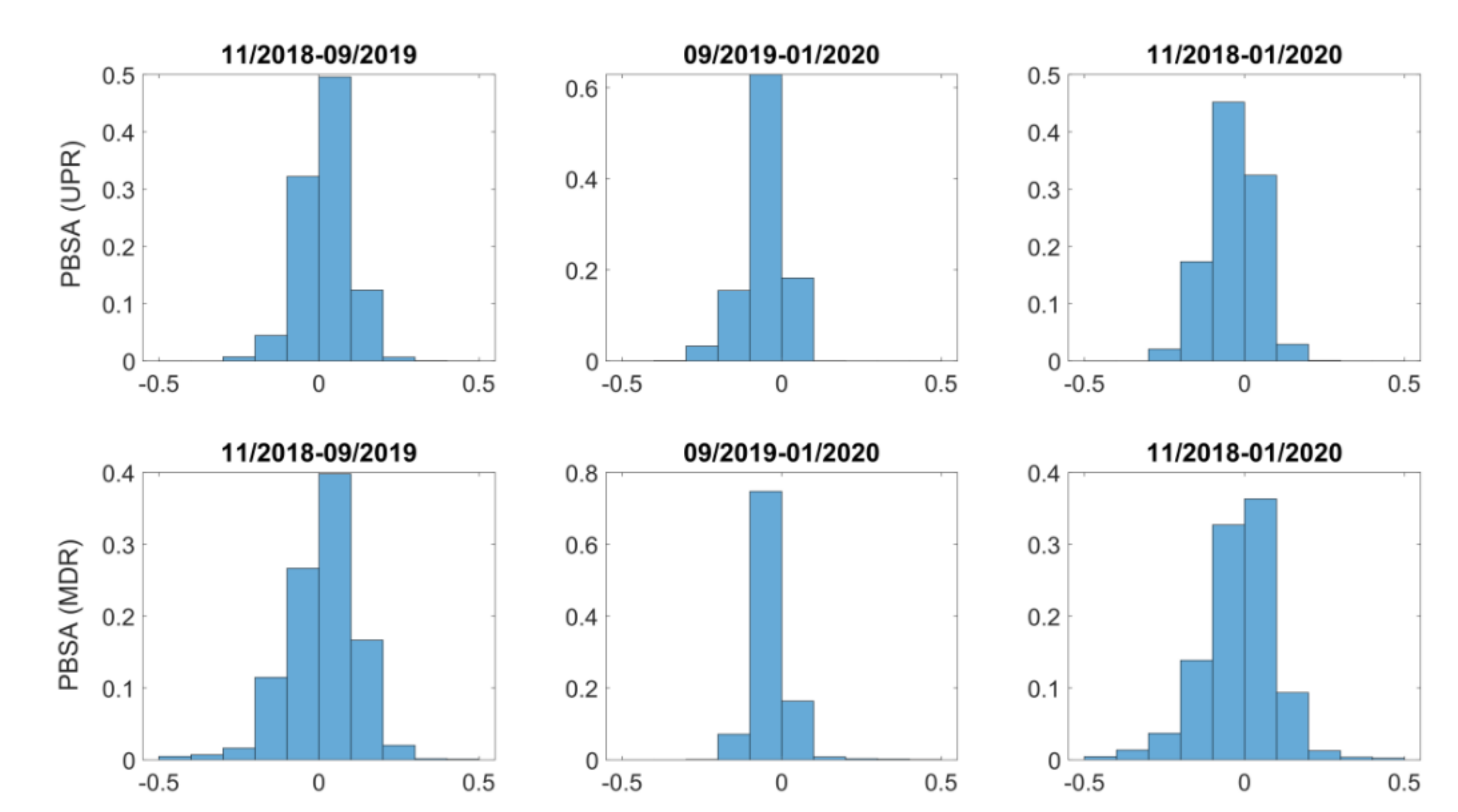
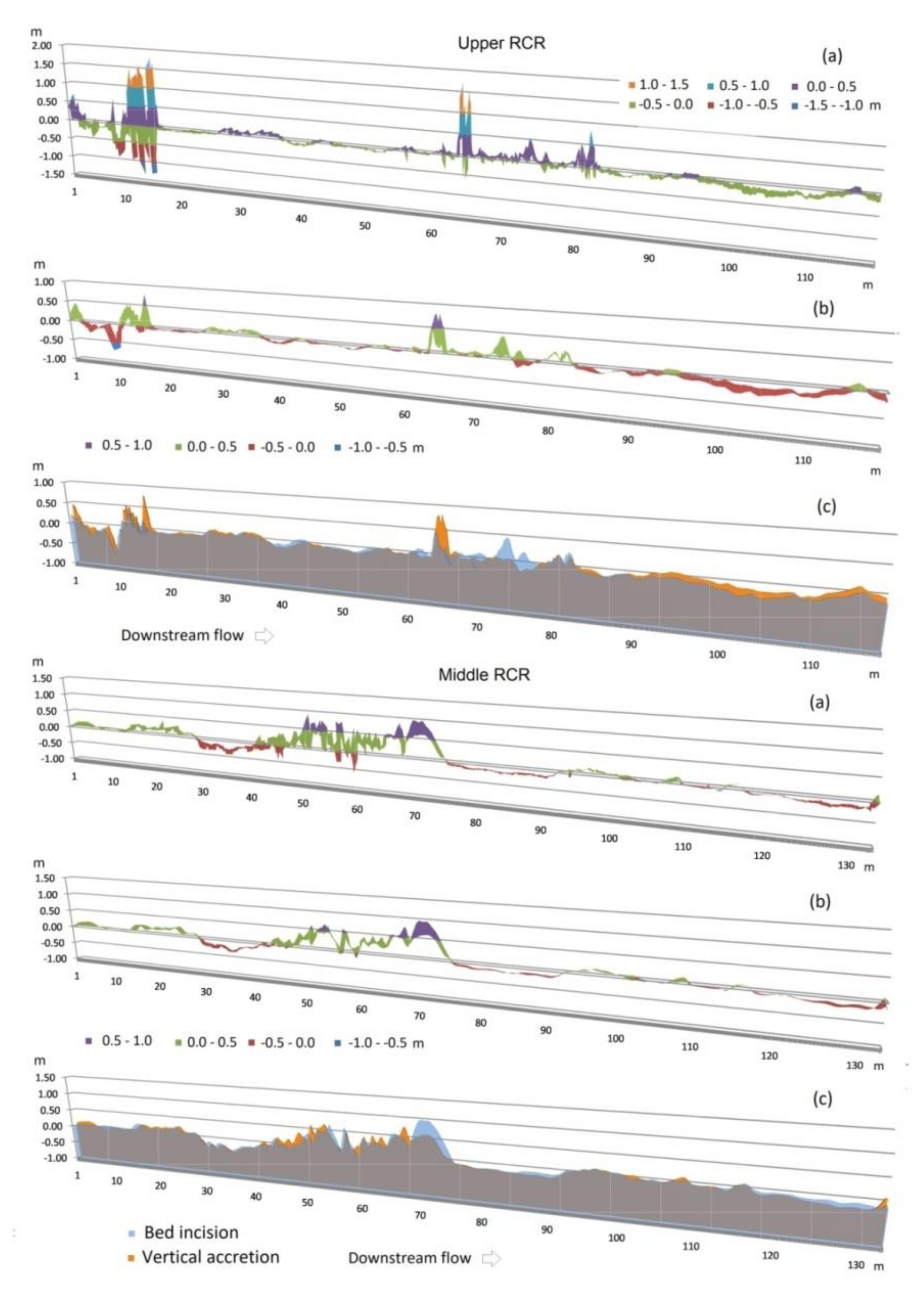



| Statistical | TAI | TNVD | ANTD | PI | TASL | TASR | UVSL | UVSR | SD* | |||||
|---|---|---|---|---|---|---|---|---|---|---|---|---|---|---|
| Channel Reach Type | m2 | m3 | % Error | m | % Error | % Value | m2 | m2 | m3 m−2 | % Error | m3 m−2 | % Error | m | |
| UPR | OVR | 4657 | 958 | 0.045 | 0.206 | 0.045 | 0.470 | 3728 | 4285 | 0.083 | 0.107 | 0.231 | 0.043 | 0.137 |
| RCR | 2763 | 614 | 0.044 | 0.222 | 0.044 | 0.486 | 67 | 2695 | 0.128 | 0.069 | 0.231 | 0.043 | 0.118 | |
| MDR | OVR | 8720 | 2093 | 0.040 | 0.240 | 0.040 | 0.489 | 234 | 8486 | 0.103 | 0.086 | 0.249 | 0.040 | 0.121 |
| RCR | 4885 | 1013 | 0.046 | 0.207 | 0.046 | 0.486 | 168 | 4717 | 0.086 | 0.102 | 0.218 | 0.046 | 0.106 | |
| Unit Volume (dm3 m−2) | Total Mean Volume per Budget Cell (dm3) | |||||||||||
|---|---|---|---|---|---|---|---|---|---|---|---|---|
| PBSA (UPR) | PBSA (MDR) | PBSA (UPR) | PBSA (MDR) | |||||||||
| Δe (m) | 2018 20191 | 2019 20202 | 2018 20203 | 2018 20191 | 2019 20202 | 2018 20203 | 2018 20191 | 2019 20202 | 2018 20203 | 2018 20191 | 2019 20202 | 2018 20203 |
| −0.5/−0.4 | −0.05 | −0.15 | −0.05 | −3.59 | −0.15 | −3.15 | −1.9 | −5.3 | −2.1 | −312.7 | −10.0 | −243.5 |
| −0.4/−0.3 | 0.00 | −0.21 | −0.02 | −2.46 | −0.02 | −4.65 | 0.0 | −7.4 | −0.6 | −214.1 | −1.3 | −359.1 |
| −0.3/−0.2 | −1.47 | −7.67 | -4.80 | −3.86 | −0.23 | −8.83 | −59.4 | −270.0 | −181.1 | −335.7 | −15.8 | −682.3 |
| −0.2/−0.1 | −6.60 | −22.54 | −22.90 | −16.14 | −9.35 | −19.74 | −266.0 | −793.6 | −865.0 | −1405.4 | −631.2 | −1525.8 |
| −0.1/0 | −11.32 | −26.36 | −19.95 | −11.35 | −23.91 | −14.32 | −456.4 | −928.4 | −753.6 | −987.7 | −1613.6 | −1106.5 |
| ΔV<0 | −19.44 | −56.93 | −47.72 | −37.40 | −33.66 | −50.69 | −783.7 | −2004.7 | −1802.4 | −3255.6 | −2271.9 | −3917.2 |
| 0/0.1 | 21.80 | 2.68 | 11.18 | 18.52 | 3.09 | 15.23 | 878.9 | 94.3 | 422.3 | 1612.5 | 208.7 | 1177.2 |
| 0.1/0.2 | 17.38 | 0.05 | 3.56 | 22.84 | 1.14 | 12.82 | 700.7 | 1.6 | 134.3 | 1988.9 | 76.7 | 991.1 |
| 0.2/0.3 | 1.38 | 0.01 | 0.19 | 4.67 | 0.79 | 2.94 | 55.6 | 0.3 | 7.0 | 406.3 | 53.6 | 227.0 |
| 0.3/0.4 | 0.16 | 0.01 | 0.01 | 0.57 | 0.70 | 1.28 | 6.3 | 0.2 | 0.2 | 49.3 | 46.9 | 99.1 |
| 0.4/0.5 | 0.27 | 0.07 | 0.22 | 0.83 | 1.69 | 2.19 | 10.9 | 2.5 | 8.4 | 72.0 | 114.4 | 169.1 |
| ΔV>0 | 40.99 | 2.82 | 15.16 | 47.43 | 7.41 | 34.46 | 1652.4 | 98.9 | 572.2 | 4129.0 | 500.3 | 2663.5 |
| ΔV | 21.55 | −54.12 | −32.58 | 10.03 | −26.25 | −16.23 | 868.7 | −1905.8 | −1230.2 | 873.4 | −1771.6 | −1253.7 |
| PBSA (UPR) | PBSA (MDR) | |||||||||||||
|---|---|---|---|---|---|---|---|---|---|---|---|---|---|---|
| ω (W m−2) | ∂ω/∂s (Wm−3) | ω/ωc (-) | ω (W m−2) | ∂ω/∂s (Wm−3) | ω/ωc (-) | |||||||||
| FlowEvent | Mean | Max | Min | Mean | Max | Min | Mean | Mean | Max | Min | Mean | Max | Min | Mean |
| 19/04/2019 | 163.4 | +8.9 | −28.8 | −3.8 | 3.8 | 1.5 | 2.6 | 145.8 | +34.1 | −26.3 | 2.8 | 2.8 | 0.5 | 1.9 |
| 12/09/2019 | 99.4 | +23.4 | −15.2 | −0.4 | 2.9 | 0.5 | 1.75 | 87.9 | +14.2 | −13.2 | 1.2 | 2.4 | 0.5 | 1.6 |
| TAI | TVDA | ATTD | PI | |||||
|---|---|---|---|---|---|---|---|---|
| RCR | Method | RGU | m2 | m3 | % Error | m | % Error | % |
| UPR | SfM | Active inter-bar bed (a) | 1367 | 318.2 | 0.043 | 0.233 | 0.043 | 0.50 |
| Active non-vegetated bar (b) | 321 | 73.4 | 0.043 | 0.228 | 0.043 | 0.50 | ||
| Low, scarcely vegetated bar (c) | 629 | 140.9 | 0.043 | 0.224 | 0.043 | 0.48 | ||
| High, scarcely vegetated bar (e) | 233 | 41.8 | 0.051 | 0.179 | 0.051 | 0.44 | ||
| Vegetated talus or bank (j) | 62 | 12.7 | 0.043 | 0.205 | 0.043 | 0.45 | ||
| TLS | Active inter-bar bed (a) | 1371 | −32.7 | −0.287 | −0.024 | −0.287 | −0.14 | |
| Active non-vegetated bar (b) | 322 | 4.5 | 0.455 | 0.014 | 0.455 | 0.11 | ||
| Low, scarcely vegetated bar (c) | 647 | 35.3 | 0.121 | 0.055 | 0.121 | 0.19 | ||
| High, scarcely vegetated bar (e) | 235 | 11.9 | 0.134 | 0.051 | 0.134 | 0.16 | ||
| Vegetated talus or bank (j) | 65 | 10.7 | 0.044 | 0.165 | 0.044 | 0.35 | ||
| MDR | SfM | Active inter-bar bed (a) | 2270 | 497.4 | 0.045 | 0.219 | 0.045 | 0.49 |
| Active non-vegetated bar (b) | 790 | 141.7 | 0.052 | 0.179 | 0.052 | 0.48 | ||
| Low, scarcely vegetated bar (c) | 925 | 188.1 | 0.046 | 0.203 | 0.046 | 0.47 | ||
| High, scarcely vegetated bar (e) | 670 | 136.1 | 0.048 | 0.203 | 0.048 | 0.49 | ||
| Scarcely vegetated talus (i) | 97 | 20.0 | 0.048 | 0.207 | 0.048 | 0.49 | ||
| TLS | Active inter-bar bed (a) | 2254 | 163.0 | 0.096 | 0.072 | 0.096 | 0.22 | |
| Active non-vegetated bar (b) | 778 | 26.0 | 0.200 | 0.033 | 0.200 | 0.14 | ||
| Low, scarcely vegetated bar (c) | 919 | 105.2 | 0.063 | 0.114 | 0.063 | 0.29 | ||
| High, scarcely vegetated bar (e) | 669 | 100.7 | 0.050 | 0.150 | 0.050 | 0.33 | ||
| Scarcely vegetated talus (i) | 103 | 3.2 | 0.203 | 0.032 | 0.203 | 0.07 | ||
Publisher’s Note: MDPI stays neutral with regard to jurisdictional claims in published maps and institutional affiliations. |
© 2020 by the authors. Licensee MDPI, Basel, Switzerland. This article is an open access article distributed under the terms and conditions of the Creative Commons Attribution (CC BY) license (http://creativecommons.org/licenses/by/4.0/).
Share and Cite
Conesa-García, C.; Puig-Mengual, C.; Riquelme, A.; Tomás, R.; Martínez-Capel, F.; García-Lorenzo, R.; Pastor, J.L.; Pérez-Cutillas, P.; Cano Gonzalez, M. Combining SfM Photogrammetry and Terrestrial Laser Scanning to Assess Event-Scale Sediment Budgets along a Gravel-Bed Ephemeral Stream. Remote Sens. 2020, 12, 3624. https://doi.org/10.3390/rs12213624
Conesa-García C, Puig-Mengual C, Riquelme A, Tomás R, Martínez-Capel F, García-Lorenzo R, Pastor JL, Pérez-Cutillas P, Cano Gonzalez M. Combining SfM Photogrammetry and Terrestrial Laser Scanning to Assess Event-Scale Sediment Budgets along a Gravel-Bed Ephemeral Stream. Remote Sensing. 2020; 12(21):3624. https://doi.org/10.3390/rs12213624
Chicago/Turabian StyleConesa-García, Carmelo, Carlos Puig-Mengual, Adrián Riquelme, Roberto Tomás, Francisco Martínez-Capel, Rafael García-Lorenzo, José L. Pastor, Pedro Pérez-Cutillas, and Miguel Cano Gonzalez. 2020. "Combining SfM Photogrammetry and Terrestrial Laser Scanning to Assess Event-Scale Sediment Budgets along a Gravel-Bed Ephemeral Stream" Remote Sensing 12, no. 21: 3624. https://doi.org/10.3390/rs12213624
APA StyleConesa-García, C., Puig-Mengual, C., Riquelme, A., Tomás, R., Martínez-Capel, F., García-Lorenzo, R., Pastor, J. L., Pérez-Cutillas, P., & Cano Gonzalez, M. (2020). Combining SfM Photogrammetry and Terrestrial Laser Scanning to Assess Event-Scale Sediment Budgets along a Gravel-Bed Ephemeral Stream. Remote Sensing, 12(21), 3624. https://doi.org/10.3390/rs12213624









